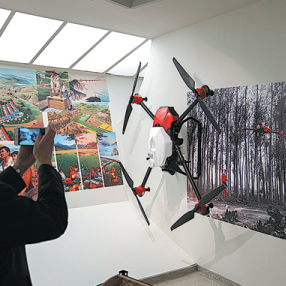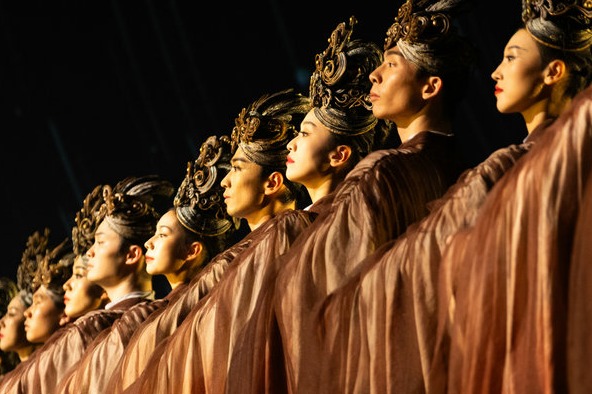Dutch architect's show highlights rural development in China

 A part of the Countryside, The Future exhibition at Solomon R.Guggenheim Museum in New York shows new technologies used in China's rural areas. WANG YING/XINHUA
A part of the Countryside, The Future exhibition at Solomon R.Guggenheim Museum in New York shows new technologies used in China's rural areas. WANG YING/XINHUA
NEW YORK-An ongoing exhibition presented by renowned Dutch architect Rem Koolhaas in New York City highlights how China has been dramatically redefining its vast countryside with continuous investment in infrastructure and efforts toward poverty alleviation.
Countryside, The Future, on view through Aug 14, aims to put the world's countryside, or the 98 percent of Earth's surface not occupied by cities "on the agenda again", Koolhaas said at Solomon R. Guggenheim Museum, where the show was unveiled to the public on Feb 21.
Drawn from original research on the the world's rapidly changing rural areas, the exhibition fills the spiralling gallery of the Guggenheim with an immersive, multisensory installation, offering an overview of rural areas from their importance in the 20th century to their current state and how they can be used in future.
China's rural revitalization, featured in the exhibition on the fourth level of the museum's rotunda, provides an important example of the ways that the countryside can be used, says Koolhaas, who has visited China frequently and who is known for his striking, often gravity-defying structures, including China Central Television's Beijing headquarters.
The installation on China's new countryside includes four sections respectively themed "collective economy", "cultural tourism", "rural e-commerce" and "high-tech agriculture", as well as a comparative study of the data of rural development in China, Europe and the United States in recent years. It is a joint project based on the field work carried out by the Central Academy of Fine Arts in Beijing and Koolhaas' research studio Office for Metropolitan Architecture in four villages in China's Henan, Guizhou, Jiangsu and Shandong provinces.
"We could not have done this without collaboration with CAFA(in Beijing) ... This furniture is designed by them and it helps (visitors) really understand what is going on in China," says Koolhaas, pointing at the tables and chairs that form a replica of an encircling conference room in rural China.
"China is currently one of the only countries that has a policy of keeping the countryside as a viable environment, as a place where there are new opportunities created," he adds.
The rural revitalization strategy, first put forward during the 19th National Congress of the Communist Party of China in 2017, aims at achieving the basic modernization of agriculture and rural areas by 2035, and the grand goal of a strong agriculture, a beautiful countryside and well-off farmers by 2050.
"I think that to some extent China is a model of what should also happen in the countryside in other territories," he says. "What we find striking, and what I think is maybe the deepest reason that I have admiration for China, is that they never give up trying, and continuously make an effort at improvement.
"It's not surprising that some of the (Chinese) posters that seemed like fantasies in the '80s are now kind of being realized simply because of the systematic work, systematic effort and systematic thinking of the Chinese in terms of their own future," he says. "If you're in China, you sense that people have a feeling that they are making their own future."
Koolhaas also praises China's contribution to sustainable rural development in other countries through its Belt and Road Initiative.
"We are showing how China deals with its own country, but we also show how China makes a contribution to other countries. We look at the railway project in Kenya, which is part of the Belt and Road (Initiative), and look at the effect of the Chinese railway in an African country."
The Chinese-built Mombasa-Nairobi Standard Gauge Railway, 485 kilometers long, saw 1,000 days of safe operations as of Feb 24, following its launch in May 2017. The modern railway replaces the meter gauge system constructed more than 100 years ago during British colonial rule.
Countryside, The Future, as noted by some experts, marks Koolhaas's embrace of the decidedly non-urban category after the architect spent decades devoted to deconstructivism and a sense of urbanity. Koolhaas launched his city-focused book Delirious New York 40 years ago.
"In this case I have a very clear message," says Koolhaas, "People predicted (that) by 2050, 80 percent of mankind will live in cities, and 20 percent of mankind will live in the countryside.
"I think we cannot tolerate and we cannot let that happen, because it means that basically the largest part of the world would be ignored, neglected, not maintained and not be there as a kind of wonderful place to go to or to exist in."
In addition to China, Koolhaas and his team also explored a series of case studies in Kenya, Germany, France, Italy and the US that address topics such as artificial intelligence, human-animal ecosystems and other phenomena that are drastically changing landscapes.
He says the exhibition is being held in one of the world's great museums in one of the world's densest cities at a time of global challenges related to sustainable development.
"Maybe it seems a little bit crazy, but New York is the center of communication in the world. Basically what I wanted to do with this show is to tell the world as much as possible that we have been looking at cities too much and that we should pay a lot more attention to the countryside than we are doing," he says.
"If you're in a city you barely notice global warming, but if you're in the countryside, or as soon as you go out of the city, you realize the weather is strange, or there are irregularities in terms of expectations.
"One of the key things that we are also showing is that this is an interesting moment, because all regimes, all political systems, are realizing that something has to be done.
"Whether they want to or not, they will have to communicate, and will have to collaborate."
Koolhaas says he is encouraged by the many visitors to his show, especially youngsters.
"It means a lot that you see young people reading. Yeah, they're reading the text. Supposedly young people are not interested in reading any more, but actually they read."





































